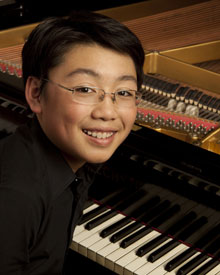
FRESH His fast playing is not only breathtaking, but beautiful — and musical. |
Sixteen-year-old Boston pianist George Li is prodigious in more than one way. He's not merely a technical wizard, but a thoughtful and serious musician. He started performing when he was nine and has won numerous international awards, played with major orchestras, and performed at the White House. He studies with one of the great piano teachers, Wha Kyung Byun, and sometimes with her husband, the legendary pianist and guru Russell Sherman. As a keyboard technician, he's as virtuosic as Lang Lang, but his palette has more colors, and his approach to playing is appealingly, touchingly music-directed, not self-directed. His fast playing is not only breathtaking, but beautiful. And musical. He not only imitates excitement, he stimulates it, never losing the musical line for the sake of a splashy, momentary flash.
His most recent Boston appearance was a recital at Jordan Hall sponsored by the Foundation for Chinese Performing Arts. It was an ambitious and varied program — variety being a central objective. Even his two selections from Ravel's Miroirs, the quietly melancholy Oiseauxtristes and the rhythmically breathtaking Alborada del gracioso ("The Buffoon's Aubade") made a point of how different his playing could be and still sound like the same player. Li began with piano-exercise master Carl Czerny's Variations on a Rode Theme, that began and ended with understated charm, and took us on a series of exhilarating finger-feats in between. Li ended the first half with a youthfully energetic, engaging, supple, and subtle Beethoven Appassionata. The last set was top-drawer Liszt (whose 200th birthday was October 22): the Two Concert Etudes — the synesthetic Waldesrauschen ("Forest Murmurs") and Gnomenreigen ("Gnome's Dance") — another study in imaginative contrasts. Also included: the brief, contemplative Consolation and the ultra-familiar Second Hungarian Rhapsody (the music for an Oscar-winning cartoon concert parody, Tom and Jerry's The Cat Concerto), which was both phenomenally brilliant, with Li incorporating Rachmaninoff's wild and dazzling cadenza, and yet fresh-sounding.
Li returned for three encores: Siloti's affectingly simple arrangement of a Bach chorale-prelude (a favorite encore of Dubravka Tomsic's but seldom played by anone else); Liszt's La Campanella; and, finally, ending on the quieter calm of Chopin's Opus Posthumous C#-minor Nocturne.
Last week's BSO program marked the return to Boston of Latvian violinist Gidon Kremer after his appearance last month in the more intimate venue of the Longy School. He played Schumann's late and generally neglected Violin Concerto (even Schumann's devoted wife Clara didn't think it was good enough to publish). But if anyone could make one love the piece, it's Kremer. I suppose the thematic material of the big first movement is less than inspired, though Kremer made it sound earnest and impassioned. The ethereal slow movement, with its exquisite if unstable harmonies, was especially poignant in the light of Schumann's approaching insanity. Kremer played with an edgy lightness — a lightness of being. And the last movement had the incisive energy it needed to carry the day.
Kremer was all nuance and drive. Conductor Rafael Frühbeck de Burgos was all roughness and weight. Kremer was playing the piece Schumann himself must have loved; Frühbeck de Burgos was playing the piece nobody liked. In her gorgeous cello solo, Martha Babcock did what Frübeck de Burgos couldn't — she bonded beautifully with Kremer, and won a deserved ovation for it afterwards.